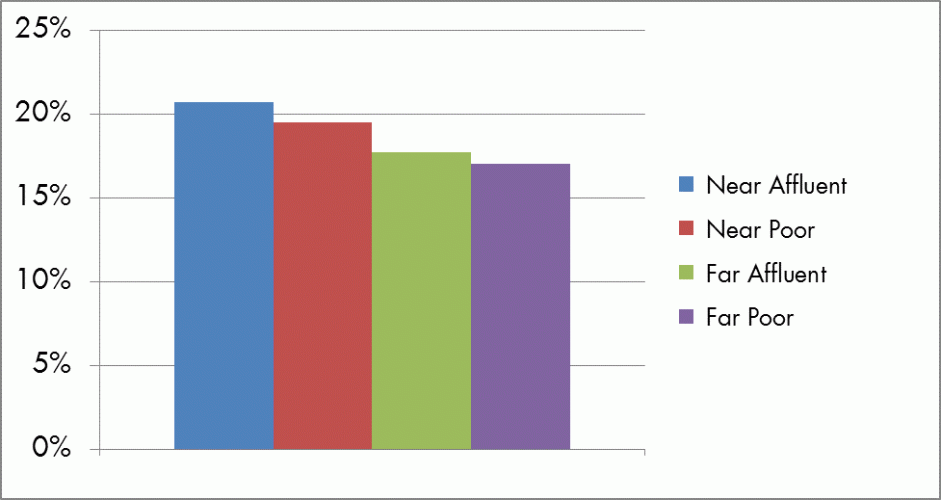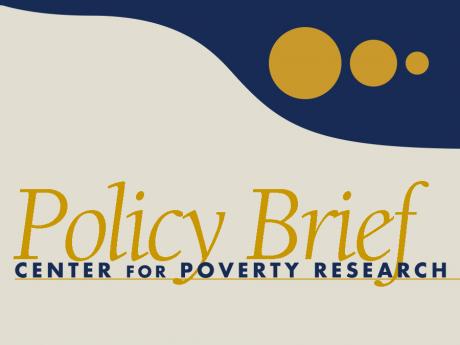Living Closer to Jobs May Improve Prospects for Low-wage Workers
By David C. Phillips, Hope College
Urban poverty has become more geographically concentrated in recent years.[1] Areas of concentrated poverty are also frequently located relatively far from many job opportunities. If low-wage employers discriminate against applicants from poor or more distant neighborhoods, those applicants and their neighborhoods may face even deeper poverty. In a new study, I find that employers are less likely to respond positively to applicants who list addresses in distant, poor neighborhoods. However, the applicant’s commute distance rather than neighborhood affluence itself is the largest factor.
The urban poor today tend to be concentrated in a small number of neighborhoods with unusually high poverty rates. According to the U.S. Census Bureau,[2] the number of people living in census tracts with poverty rates of at least 20 percent increased from 49.5 million (18.0%) in 2000 to 77.4 million (25.7%) in 2008-12. Problems such as higher crime rates, poor housing conditions and fewer job opportunities may be exacerbated when poor families live in concentrated poverty.[3]
Key Facts
- Fictional résumés randomly assigned addresses far from the job location receive 14% fewer callbacks from employers than nearby addresses.
- Living 5-6 miles away from the job results in a penalty equal to that received by applicants with names that according to Census data are common among African Americans.
- Because commute distances and neighborhood poverty tend to be highly correlated, this effect may account for two-thirds of discrimination against applicants from poor neighborhoods measured in previous experiments.
- Location and transportation may then be most important for overcoming discrimination against job applicants from poor neighborhoods.
Distance from jobs may create a number of additional difficulties for low-wage workers. A large body of literature[4] argues that living far from job opportunities may create challenges in the labor market. Researchers have also argued[5] that concentrated poverty results directly from living in neighborhoods that are geographically far from jobs.
Employer discrimination could be one way that distance reduces employment success if employers discriminate against applicants from more distant neighborhoods. Research shows that employers respond less positively to applicants who live in poor neighborhoods,[6] but this previous work does not investigate whether employers are responding to neighborhood poverty or the fact that poor neighborhoods tend to be farther away from jobs.
Studying the Low-wage Labor Market
In a new study, I conduct a correspondence experiment of the low-wage labor market in Washington, D.C. to test whether employers discriminate against applicants from poor and/or distant neighborhoods. I submitted 2,260 fictional job applications to 565 actual online job postings that required only a high school education. I then tested whether the applicant’s address affected the likelihood of a positive response.
Applicant addresses were in one of four distance/affluence categories: near and poor (NP), near and affluent (NA), far and poor (FP), or far and affluent (FA). NA and NP addresses were on average 3.0 miles from jobs to which they applied. FA and FP addresses were between 5.3 and 5.8 miles away. NP and FP neighborhoods had median incomes $74,000 lower on average, 50 percentage points fewer college graduates and 40 percentage points fewer Whites. Applications were sent to jobs which tended to be in high-income, well-educated, predominantly White neighborhoods near downtown.
All other information on the application, such as years of work experience, made each group on average identical. The fictional applicants had only a high school education but were highly qualified for jobs as administrative assistants, cooks, fast food line workers, servers, janitors, building maintenance technicians, retail sales associates and valet drivers. Applicant names were selected following previous studies to indicate White, Black or ambiguous identities. Each job received applications evenly split between male and female applicants.
Distance Lowers Callbacks
Employers were less likely to contact applicants living in distant, high poverty neighborhoods, with the biggest reduction in call-back rates associated with long commute distances. For instance, NP addresses received a 19.5 percent callback rate, compared to a 17.0 percent callback rate for FP addresses. Overall, addresses farther from the job were 2.7 percentage points less likely to receive a callback.
Employers may respond to the commute distance of applicants because commuting lowers workers’ productivity. A worker living far from home may be more tired upon arriving at work, or the need to transfer between multiple forms of public transit may prevent a worker from arriving at a reliable time. On the other hand, employers may respond to workers’ commutes using statistical discrimination. This puts at a disadvantage even workers who have long commutes but not necessarily lower productivity.
Statistical discrimination can occur when employers or others use a group’s average characteristics to predict individual outcomes such as job attachment or productivity. If employers observe that, on average, workers with far commutes perform poorly or turn over quickly, they may be less likely to hire workers who live farther away, statistically discriminating based on the historic behavior of the group.
Geography and Race
For context, I compared this result to race-based differences in response rates (as have been documented in previous research). Individuals with names that according to Census data are common among African Americans received six percentage points fewer callbacks than those with ambiguous or White names.
An applicant living 2.6 miles farther from the job received at least 2.4 percentage points fewer callbacks. This represents 40 percent of the penalty for applicants with a Black name. Extrapolating this effect suggests that living 6.5 miles farther from the job leads to a similar reduction in employer response rates as having a commonly Black name.
This evidence provides less support for the theory that employers discriminate according to the poverty of the neighborhood itself. Applicants with FA addresses receive a callback rate of 17.7 percent, which is close to (and not statistically distinguishable from) the 17.0 percent callback rate of those with FP addresses. NP addresses receive only a slightly lower callback rate of 19.5 percent compared to the 20.7 percent for NA addresses.
Improving Opportunity for Workers
Increasing opportunities for economic mobility is particularly important for low-income workers and their families. Recent research suggests that higher economic mobility correlates with lower rates of both residential segregation and income inequality.[7]
This study shows that employer discrimination by commuting distance exists. Thus, employer behavior can translate disparate housing markets into disparate labor markets. The fact that employers consider commute distance in the hiring process can help to inform future public policy responses.
Housing interventions have focused on moving low-income residents to more affluent neighborhoods, but this study suggests that moving them closer to jobs could be more effective. This points to the possibility that improved or subsidized public transit to bridge areas of concentrated poverty and jobs could have positive impacts.
David C. Phillips is an Assistant Professor of Economics at Hope College. This study was funded in part by a Center for Poverty Research Small Grant.
1 Kneebone, E. 2014. “The Growth and Spread of Concentrated Poverty, 2000 to 2008-2012.” Brookings Institution Research Brief.
2 Bishaw, A. 2014. “Changes in Areas With Concentrated Poverty: 2000 to 2010.” U.S. Census Bureau.
3 Kneebone, 2014.
4 Kain, J. 1968. “Housing Segregation, Negro Employment, and Metropolitan Decentralization.” Quarterly Journal of Economics.
5 Wilson, W.J. 1997. When Work Disappears: The World of the New Urban Poor. Vintage Books.
6 Bertrand, M. et al. 2004. “Are Emily and Greg More Employable Than Lakisha and Jamal.” American Economic Review.
7 Chetty, R., et al. 2014. “Where if the Land of Opportunity? The Geography of Intergenerational Mobility in the United States.” Quarterly Journal of Economics.
#povertyresearch















